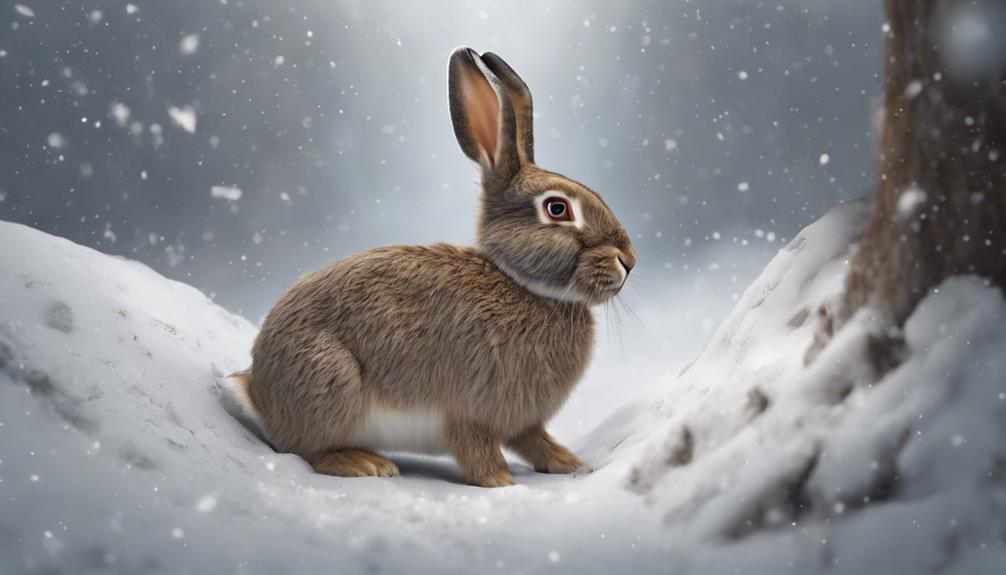Three Tips: Climate's Role in Rabbit Ecology
Imagine if climate played a minor role in the lives of rabbits. Well, that's far from reality. The intricate dance between climate and rabbit ecology holds crucial insights that can't be ignored.
From temperature preferences to extreme weather adaptations, understanding these dynamics can unravel fascinating secrets about rabbit populations.
So, how does climate truly shape the world of these small, yet resilient creatures?
Rabbit Habitats and Climate
When considering rabbit habitats and climate, it's crucial to understand how these factors interact to shape the living conditions for these small mammals. Climate adaptation plays a significant role in determining the distribution and behavior of rabbits. These animals have evolved different strategies to cope with varying climates, such as thick fur for insulation in cold regions or large ears for heat dissipation in warmer areas. Understanding these adaptations is key to comprehending how rabbits thrive in diverse environments.
Habitat suitability is another critical aspect when discussing rabbit ecology. Rabbits are highly adaptable creatures that can inhabit a wide range of environments, including forests, grasslands, deserts, and even urban areas. The availability of food, water, shelter, and suitable breeding sites all contribute to the suitability of a habitat for rabbits. Factors like vegetation cover, predator presence, and human disturbances also play a role in determining whether a habitat can support a rabbit population.
Temperature Preferences of Rabbits
Exploring the temperature preferences of rabbits sheds light on how these small mammals adapt to varying environmental conditions. Rabbits have a remarkable ability to regulate their body temperature, which makes their burrows crucial for surviving extreme weather patterns. These underground shelters provide insulation, shielding them from both scorching heat and freezing cold. During hot weather, rabbits retreat to the cooler depths of their burrows, where the temperature remains relatively stable and comfortable. Conversely, in cold conditions, they huddle together in their burrows to conserve body heat and stay warm.
Burrow temperature plays a critical role in the survival of rabbits, especially during periods of extreme weather. By seeking refuge underground, rabbits can avoid the harmful effects of temperature fluctuations and stay within their preferred thermal range. Weather patterns influence the temperature inside the burrows, making it essential for rabbits to adapt their behavior accordingly. Understanding these temperature preferences is vital for conservation efforts, as changes in climate can impact the availability of suitable habitats for rabbits.
Impact of Precipitation on Rabbits
Rabbits rely on their burrows not only for regulating temperature but also for seeking shelter from the varying impacts of precipitation. Rainfall patterns play a crucial role in the life of rabbits, affecting their foraging activities and overall well-being. The availability of water is essential for rabbits to thrive, and precipitation directly influences this factor.
In regions with consistent rainfall, rabbits have easier access to water sources, which is vital for their survival. Adequate water availability allows rabbits to maintain their health, support their reproductive activities, and sustain their energy levels for foraging. On the other hand, prolonged droughts can lead to water scarcity, forcing rabbits to travel longer distances in search of water, which can be exhausting and risky.
Moreover, rainfall patterns affect the vegetation growth, which in turn influences the availability of food for rabbits. In areas with seasonal rainfall, rabbits may need to adapt their foraging behaviors to find food during periods of scarcity. Changes in precipitation can also impact the reproductive success of rabbits, as a lack of water and food resources may lead to decreased breeding rates and survival of young.
Therefore, understanding the relationship between precipitation and rabbits is crucial for conservation efforts and managing their populations in the face of changing climates.
Seasonal Changes and Rabbit Behavior
During seasonal changes, rabbit behavior adapts to the shifting environmental conditions to ensure survival and reproductive success. One key aspect of this adaptation is burrow construction. As seasons transition, rabbits modify their burrows to provide better insulation against extreme temperatures. In colder months, they may deepen their burrows and line them with extra fur or grass for warmth, while in warmer months, they adjust the burrow openings to improve ventilation and regulate internal temperatures. This behavior helps rabbits maintain a comfortable living environment throughout the year.
In terms of foraging strategies, rabbits also adjust their behavior based on seasonal changes. During the spring and summer when food is abundant, rabbits focus on consuming fresh greens and vegetation to support their energy needs and reproduction. In contrast, during fall and winter when food sources become scarce, rabbits may expand their foraging range or rely more on stored food reserves within their burrows. This flexibility in foraging behavior allows rabbits to adapt to the fluctuations in food availability across different seasons.
Drought Resilience in Rabbit Populations
Adapting to prolonged dry spells, rabbit populations exhibit remarkable resilience in the face of drought conditions. During periods of drought, food availability becomes scarce, impacting various aspects of rabbit ecology. However, rabbits have developed strategies to cope with these challenges.
Rabbits are known for their ability to adjust their diets based on food availability. When faced with drought, they can switch to consuming a wider range of plants and rely on moisture from their food to sustain themselves. This adaptability helps them survive when their typical food sources are limited.
Moreover, drought can influence reproductive success in rabbit populations. Female rabbits may delay breeding during times of drought when resources are scarce. This delay in reproduction allows them to conserve energy for their own survival and potentially for future breeding when conditions improve. Additionally, rabbits are known for their high reproductive rates when environmental conditions are favorable. They can quickly repopulate areas once drought conditions ease and food sources become more abundant.
In essence, the resilience of rabbit populations to drought conditions is closely tied to their ability to adjust their diets and reproductive strategies based on food availability. These adaptations enable them to withstand challenging environmental conditions and thrive in the face of adversity.
Snowfall Effects on Rabbit Ecology
In the face of changing environmental conditions, the impact of snowfall on rabbit ecology becomes a pivotal factor in understanding their adaptive mechanisms. Snow cover during winter plays a crucial role in shaping the survival strategies of rabbits in the wild.
- Winter Survival: Snowfall can significantly impact the ability of rabbits to find food and shelter during the harsh winter months. The depth of snow cover can make it challenging for rabbits to access vegetation, their primary food source, leading to potential food scarcity and increased competition among individuals for limited resources.
- Camouflage and Predation: Snowfall alters the landscape, affecting the camouflage capabilities of rabbits. While their white fur may provide some level of concealment in snowy environments, increased snow cover can make it easier for predators to spot them against the white backdrop. This dynamic creates a constant evolutionary pressure for rabbits to adapt their behaviors and movement patterns to avoid predation.
- Behavioral Adaptations: In response to heavy snowfall, rabbits may alter their foraging routines, shifting to areas with less snow cover or resorting to feeding on bark and twigs when vegetation is inaccessible. These behavioral adaptations showcase the resilience of rabbits in the face of challenging winter conditions, highlighting their ability to adjust their strategies for survival.
Extreme Weather Adaptations of Rabbits

Rabbits demonstrate remarkable resilience in extreme weather conditions through their adaptive behaviors. These small mammals have evolved to cope with a variety of weather patterns and environmental challenges. When faced with extreme heat, rabbits use their large ears to regulate body temperature by dissipating heat. They also seek shade and cooler areas to avoid overheating. In contrast, during cold spells, rabbits rely on their thick fur coats to provide insulation and keep warm. They may burrow deeper into the ground or huddle together with other rabbits for additional warmth.
In times of heavy rainfall or flooding, rabbits showcase their agility by swiftly navigating through waterlogged areas to find higher ground. Their powerful hind legs enable them to jump and escape rising waters, showcasing their ability to adapt to sudden environmental challenges. Additionally, rabbits have a keen sense of smell and can detect changes in weather patterns, allowing them to prepare for upcoming storms or adverse conditions.
Climate Change Threats to Rabbit Habitats
Climate change poses a significant threat to the habitats of these resilient small mammals. As temperatures fluctuate and extreme weather events become more common, rabbit populations are facing new challenges that impact their ability to thrive in their natural habitats.
- Habitat Fragmentation:
Climate change is leading to habitat fragmentation for rabbits, with rising temperatures altering the landscapes where these small mammals reside. As habitats become more fragmented, rabbits struggle to find suitable areas for shelter, foraging, and breeding, ultimately affecting their overall population dynamics.
- Temperature Fluctuations:
The increasing frequency of temperature fluctuations due to climate change can have detrimental effects on rabbit populations. These fluctuations can disrupt the timing of key life events for rabbits, such as breeding seasons and foraging patterns, leading to decreased reproductive success and overall population decline.
- Impact on Rabbit Populations:
Ultimately, the combination of habitat fragmentation and temperature fluctuations poses a significant threat to rabbit populations. As their habitats change and become less predictable, rabbits face increased challenges in adapting and surviving in their changing environments. Conservation efforts focused on mitigating the effects of climate change on rabbit habitats are crucial to ensuring the long-term survival of these small mammals.
Frequently Asked Questions
Can Rabbits Survive in Extreme Heat Conditions?
In extreme heat conditions, rabbits may struggle due to heat stress affecting their behavior. However, these resilient creatures have survival strategies deeply rooted in their physiology.
They can seek shade, dig burrows for cool shelter, and regulate body temperature through behaviors like panting. By adapting and finding ways to stay cool, rabbits can better endure and survive in challenging high-temperature environments.
How Do Rabbits Adapt to Changes in Humidity Levels?
When humidity levels change, rabbits adapt by adjusting their burrow construction and foraging strategies. This helps them find shelter and food more efficiently. Such adaptations are crucial for their reproductive success and maintaining stable population dynamics.
Do Rabbits Hibernate During Harsh Weather Conditions?
During harsh weather conditions, rabbits don't hibernate. They exhibit winter behavior by using burrowing strategies to stay warm and safe.
When faced with food scarcity, they employ survival tactics, such as foraging on bark and twigs.
What Impact Does Air Pollution Have on Rabbit Populations?
Air pollution from urban development can have detrimental effects on rabbit populations. Pollution can impact rabbit health by contaminating their habitats and food sources, leading to respiratory issues and other health problems.
As pollution levels increase, it becomes harder for rabbits to thrive in these areas, ultimately affecting their population numbers. It's crucial to address pollution in rabbit habitats to ensure the well-being and sustainability of these creatures.
Are There Any Specific Plant Species That Rabbits Rely on During Droughts for Food and Shelter?
During droughts, rabbits rely on specific plant species for food and shelter to enhance their drought resilience. Plant diversity becomes crucial, providing various options for shelter and sustenance.
Some plants offer heat tolerance and humidity adaptation, aiding rabbits in surviving harsh conditions. Additionally, hibernation behavior can help conserve energy during resource scarcity.
This reliance on plant species showcases the intricate link between vegetation and rabbit population dynamics in challenging climates.
Conclusion
Overall, understanding the impact of climate on rabbit ecology is crucial for their survival. By considering temperature preferences, precipitation levels, seasonal changes, and extreme weather adaptations, we can better protect rabbit populations from the threats of climate change.
It's important to monitor and adapt to changing environmental conditions to ensure the resilience and sustainability of rabbit habitats in the face of a changing climate.
